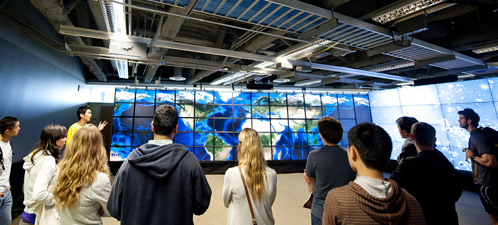
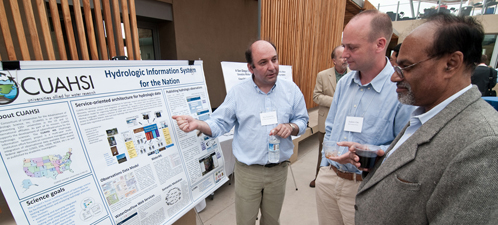


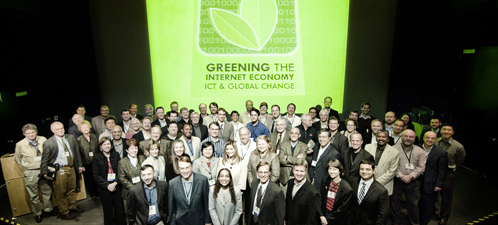
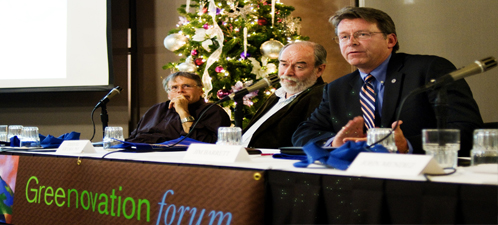
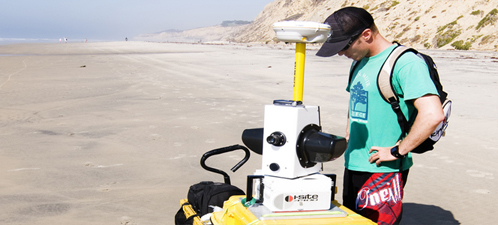
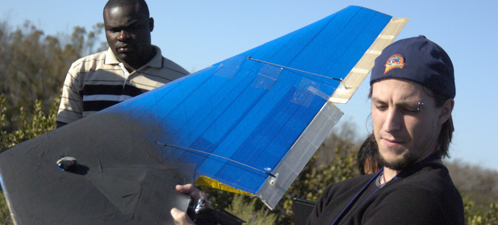
This is a draft alphabetical list of the campus academic partners Calit2 is working with to realize the institute's application vision for the environment. The list contains centers, facilities, labs and large grants, but Calit2 also works closely with many individual faculty, schools and departments, as well as many private companies.
California Applications Program (CAP) and California Climate Change Center (CCCC)
CAP and CCCC aim to develop and provide better climate information and forecasts for decision makers in California and the surrounding region. By working directly with users, they are working to evaluate climate information needs and utility from the user perspective. http://meteora.ucsd.edu/cap/
Center for Hydrometeorology and Remote Sensing (CHRS)
Through interdisciplinary research and education involving faculty and students in engineering, physical sciences, and social ecology, CHRS focuses on building global capacity for hydrometeorological observations and forecasts to mitigate hydrologic disasters and manage water resources. CHRS at UC Irvine is achieving these goals, through the development of means to extend the benefits of space and weather agencies' vast technological resources, which are untapped, into applications that can assist hydrologists and water resource managers worldwide and through equitable access to relevant information. http://chrs.web.uci.edu
Center for Unconventional Security Affairs (CUSA)
The Center for Unconventional Security Affairs at UCI is the innovative hub of a global network established in 2003 to study new environmental and human security challenges. CUSA undertakes interdisciplinary research to understand and develop solutions to challenges such as the human dimensions of climate change; the links between environment, conflict, and peace; global terrorist networks; and transnational threats to health and food security. Research and education programs are conducted through an innovative global network that includes faculty and students. CUSA researchers and students have conducted research fieldwork in more than 25 countries and on all seven continents, including Antarctica. http://www.cusa.uiuc.edu
Global Action Research Center (Global ARC)
The Global ARC is a not-for-profit organization (501c3) lead by a mix of educators, researchers, scientists, professionals and community organizers all of whom are dedicated to critical study, open dialog, social learning and creative problem solving. The Global ARC builds community-based research collaboratives, knowledge commons, networks and tools to enable people to work together-locally and globally-in ways that create sustainable livelihoods, common wealth and well-being while eradicating root causes of poverty, environmental degradation and unhealthy living conditions. The organization focuses on food, water, and energy. http://www.theglobalarc.org
High Performance Wireless Research and Education Network (HPWREN)
HPWREN is a National Science Foundation-funded network research project, which also functions as a collaborative cyberinfrastructure for research, education and first-responder activities. It includes creating, demonstrating and evaluating a non-commercial, prototype, high-performance, wide-area, wireless network in San Diego, Riverside, and Imperial counties. The network includes backbone nodes at the UC San Diego and San Diego State University campuses, and a number of "hard to reach" areas in remote environments. http://hpwren.ucsd.edu/
Ocean Observatories Initiative (OOI)
The Ocean Observatories Initiative is an NSF Major Research Equipment and Facilities Construction program that will conduct transformational ocean science using an integrated ocean observatory with a network of interactive nodes studying interrelated ocean processes on coastal, regional, and global spatial scales and through a continuum of time scales, from microseconds to decades. The Cyberinfrastructure component, led by UCSD, provides the common operating infrastructure connecting and coordinating the operations of the integrated observatories (coastal, regional and global) with the scientific and educational pursuits of the oceanographic research communities. The long-term objective is to couple with minimal human intervention the observation, modeling and mission control systems, making them accessible to all. http://ci.oceanobservatories.org/
The Regional Workbench Consortium (RWBC)
The RWBC is a collaborative network of university researchers and community-based partners dedicated to studying/enabling sustainable city-region development in the Southern California-Northern California border region. The RWBC is building a trusted Internet-based research portal and toolkit (i.e., workbench) to facilitate projects that require region-wide data integration and information sharing. http://regionalworkbench.org
San Diego Supercomputer Center (SDSC)
Scientists and engineers increasingly rely on the availability of globally accessible information "cyberinfrastructure" to drive research and education. Cyberinfrastructure provides a broad and useful spectrum of integrated technologies to support increasingly complex, large-scale and cooperative scientific endeavors. Most science and engineering users work from a "home" research laboratory, academic department or local environment. When a research project's technological needs outgrow the capabilities of their home environment, cyberinfrastructure can "extend the reach" of the scientist by providing needed databases, computation, and other resources remotely. SDSC provides an integrated set of software, services and environments. http://www.sdsc.edu
Scripps Institution of Oceanography
With more than a century of exploration and discovery in global sciences, Scripps is the world's preeminent center for ocean and earth research, teaching and public education. A graduate school of UC San Diego, Scripps's leadership in many scientific fields reflects its continuing commitment to excellence in research, modern facilities and ships, distinguished faculty, and outstanding students. Research encompasses physical, chemical, biological, geological and geophysical studies of the ocean and earth. http://scripps.ucsd.edu
UC Center for Hydrological Modeling
UCI has been awarded $2.5 million for satellites and field research to determine more accurately how much water exists in California and where it has been located. The UC Office of the President funding will create the UC Center for Hydrologic Modeling under the guidance of UCI Earth System Science Professor James Famiglietti. Research will focus on combining computer models with observations to determine how much water exists in underground aquifers, the soil, and the snowpack.
UCI Environment Institute
The UC Irvine Environment Institute: Global Change, Energy, and Sustainable Resources was created in April 2008 as a new research institute dedicated to the study of interactions between the environment and society. The institute enhances the already internationally recognized work in environmental and related studies occurring across UC Irvine, beginning with support of on-campus research projects and recruitment of new faculty. The overall goals are to strengthen and link academic programs in environmental studies across schools and departments, develop a coherent image of the breadth and quality of ongoing research in the environment and related fields, and enhance the rise of UC Irvine as a leader in addressing the challenges of global change, energy, and sustainable resources. The institute also encourages organizational efforts directed at improving sustainable practices on the UC Irvine campus. http://environment.uci.edu
UCSD Sustainability Solutions Institute (SSI)
SSI turns knowledge and technology into solutions. Created in January 2009 and building on recent cross-campus initiatives and long-standing academic and research programs, SSI serves to acquire resources and organize projects to address sustainability challenges. Initial areas of focus are integrated resource management (starting with climate impacts on water systems); the built environment and sustainable communities; and Greenovation, a program for research commercialization. http://ssi.ucsd.edu
Urban Water Research Center (UWRC)
It is widely accepted that water will be the "oil" of the 21st Century. Unlike oil, however, the planet cannot survive without water. Ecosystem and human health - the quality of life on the planet - depend upon water. The UWRC - with over 80-affiliated faculty and several world-class facilities lending support - is well positioned to aggressively tackle the wide range of important issues associated with water today. Social and political scientists, engineers, as well as physical, biological and medical scientists have come together to collaborate through the center. http://www.uwrc.uci.edu
